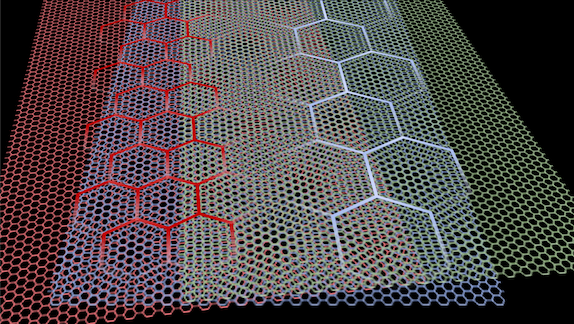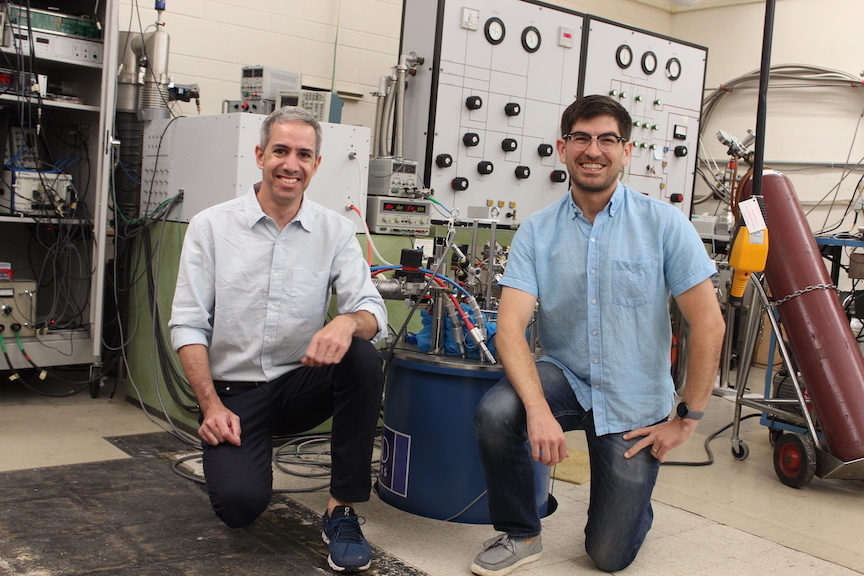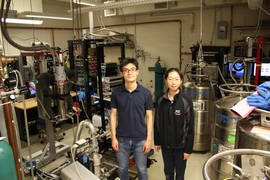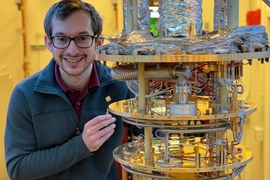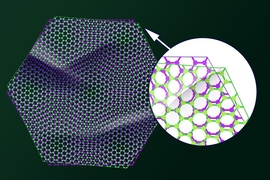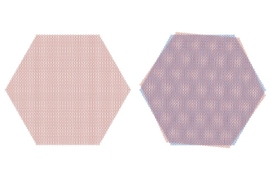In research that could jump-start interest into an enigmatic class of materials known as quasicrystals, MIT scientists and colleagues have discovered a relatively simple, flexible way to create new atomically thin versions that can be tuned for important phenomena. In work reported in a recent issue of Nature, they describe doing just that to make the materials exhibit superconductivity and more.
The research introduces a new platform for not only learning more about quasicrystals, but also exploring exotic phenomena that can be hard to study but could lead to important applications and new physics. For example, a better understanding of superconductivity, in which electrons pass through a material with no resistance, could allow much more efficient electronic devices.
The work brings together two previously unconnected fields: quasicrystals and twistronics. The latter is the specialty of Pablo Jarillo-Herrero, the Cecil and Ida Green Professor of Physics at MIT and corresponding author of the new Nature paper, whose “magic-angle” graphene breakthrough in 2018 jump-started the field.
“It's really extraordinary that the field of twistronics keeps making unexpected connections to other areas of physics and chemistry, in this case the beautiful and exotic world of quasiperiodic crystals," says Jarillo-Herrero, who is also affiliated with MIT’s Materials Research Laboratory and the MIT Research Laboratory of Electronics.
Do the twist
Twistronics involves atomically thin layers of materials placed on top of one another. Rotating, or twisting, one or more of the layers at a slight angle creates a unique pattern called a moiré superlattice. And a moiré pattern, in turn, has an impact on the behavior of electrons. “It changes the spectrum of energy levels available to the electrons and can provide the conditions for interesting phenomena to arise,” says Sergio C. de la Barrera, one of four co-first authors of the recent paper. De la Barrera, who conducted the work while a postdoc at MIT, is now an assistant professor at the University of Toronto.
A moiré system can also be tailored for different behaviors by changing the number of electrons added to the system. As a result, the field of twistronics has exploded over the last five years as researchers around the world have applied it to creating new atomically thin quantum materials. Examples from MIT alone include:
- Turning a moiré material known as magic-angle twisted bilayer graphene into three different — and useful — electronic devices. (The scientists involved in that work, reported in 2021, included Daniel Rodan-Legrain, a co-first author of the current work and an MIT postdoc in physics. They were led by Jarillo-Herrero.)
- Engineering a new property, ferroelectricity, into a well-known family of semiconductors. (The scientists involved in that work, reported in 2021, were led by Jarillo-Herrero.)
- Predicting exotic new magnetic phenomena, complete with a “recipe” for realizing them. (The scientists involved in that work, reported in 2023, included MIT professor of physics Liang Fu and Nisarga Paul, an MIT graduate student in physics. Both Fu and Paul are co-authors of the current paper.)
Toward new quasicrystals
In the current work, the researchers were tinkering with a moiré system made of three sheets of graphene. Graphene is composed of a single layer of carbon atoms arranged in hexagons resembling a honeycomb structure. In this case, the team layered three sheets of graphene on top of one another, but twisted two of the sheets at slightly different angles.
To their surprise, the system created a quasicrystal, an unusual class of material discovered in the 1980s. As the name implies, quasicrystals are somewhere between a crystal, such as a diamond, that has a regular repeating structure, and an amorphous material, like glass, “where the atoms are all jumbled, or randomly arranged,” says de la Barrera. In a nutshell, quasicrystals “have really strange patterns,” de la Barrera says (see some examples here).
Compared to crystals and amorphous materials, however, relatively little is known about quasicrystals. That’s in part because they’re hard to make. “That doesn’t mean they’re not interesting; it just means that we haven’t paid as much attention to them, particularly to their electronic properties,” says de la Barrera. The new platform, which is relatively simple, could change that.
Learning more
Because the original researchers weren’t experts in quasicrystals, they reached out to someone who is: Professor Ron Lifshitz of Tel Aviv University. Aviram Uri, one of the co-first authors of the paper and an MIT Pappalardo and VATAT Postdoctoral Fellow, was a student of Lifshitz’s during his undergraduate studies at Tel Aviv and knew about his work on quasicrystals. Lifshitz, who is also an author of the Nature paper, helped the team to better understand what they were looking at, which they call a moiré quasicrystal.
The physicists then tuned a moiré quasicrystal to make it superconducting, or transmit current with no resistance at all below a certain low temperature. That’s important because superconducting devices could transfer current through electronic devices much more efficiently than is possible today, but the phenomenon is still not fully understood in all cases. The new moiré quasicrystal system brings a new way to study it.
The team also found evidence of symmetry breaking, another phenomenon that “tells us that the electrons are interacting with one another very strongly. And as physicists and quantum material scientists, we want our electrons interacting with each other because that’s where the exotic physics happens,” de la Barrera says.
In the end, “through discussions across continents we were able to decipher this thing, and now we believe we have a good handle on what’s going on,” says Uri, although he notes that “we don’t yet fully understand the system. There are still quite a few mysteries.”
The best part of the research was “solving the puzzle of what it was we had actually created,” de la Barrera says. “We were expecting [something else], so it was a very pleasant surprise when we realized we were actually looking at something very new and different.”
“It’s the same answer for me,” says Uri.
Additional authors of the Nature paper are MIT professor of physics Raymond C. Ashoori; Mallika T. Randeria, a researcher at MIT Lincoln Laboratory who conducted the work as a Pappalardo Fellow at MIT and is another co-first author of the paper; Trithep Devakul, an assistant professor at Stanford University who conducted the work as a postdoc at MIT; Philip J. D. Crowley, a postdoc at Harvard University; and Kenji Watanabe and Takashi Taniguchi of the National Institute for Materials Science in Japan.
This work was funded by the U.S. Army Research Office, the U.S. National Science Foundation, the Gordon and Betty Moore Foundation, a MIT Pappalardo Fellowship, a VATAT Outstanding Postdoctoral Fellowship in Quantum Science and Technology, the JSPS KAKENHI, and the Israel Science Foundation.
